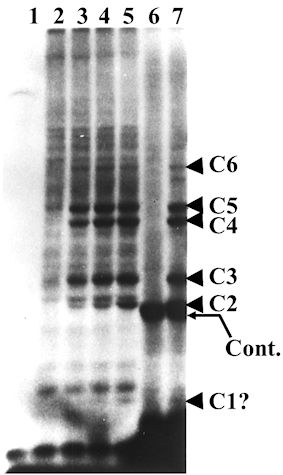
Figure 4.
Multiple molecules of APF-1/ubiquitin are conjugated to the proteolytic substrate, probably signaling it for degradation.
To interpret the data described in the experiment depicted in Figure 2 and to test the hypothesis that APF-1 is conjugated to the target proteolytic substrate, 125I-APF-1/ubiquitin was incubated along with crude fraction II (Figure 3 and text) in the absence (lane 1) or presence (lanes 2–5) of ATP and in the absence (lanes 1 and 2) or presence (lanes 3–5) of increasing concentrations of unlabeled lysozyme. Reaction mixtures resolved in lanes 6 and 7 were incubated in the absence (lane 6) or presence (lane 7) of ATP, and included unlabeled APF-1/ubiquitin and 125I-labeled lysozyme. C1–C6 denote specific APF-1/ubiquitin-lysozyme adducts in which the number of APF-1/ubiquitin moieties bound to the lysozyme moiety of the adduct is increasing, probably from 1 to 6. Reaction mixtures were resolved via sodium dodecyl sulfate-polyacrylamide gel electrophoresis (SDS-PAGE) and visualized following exposure to an X-ray film (autoradiography) (with permission from Proceedings of the National Academy of the USA; published originally in Hershko et al.40).